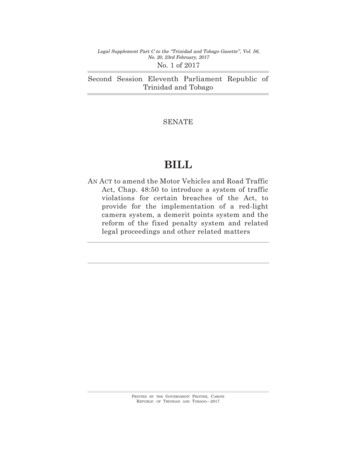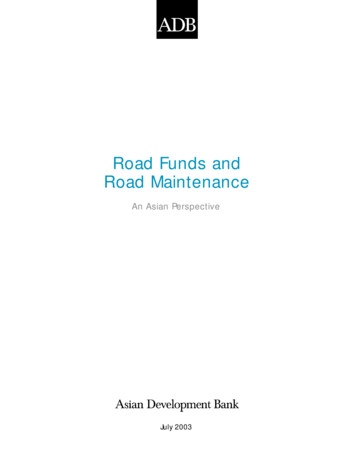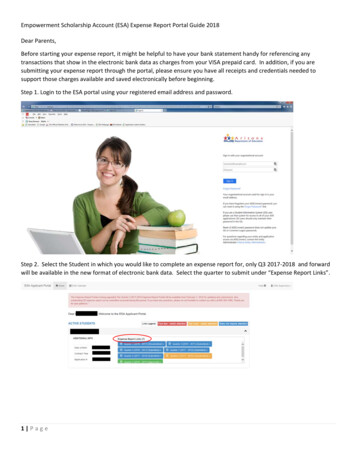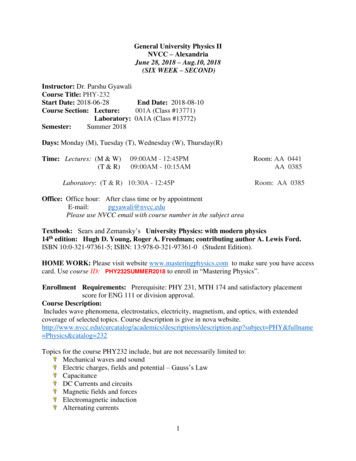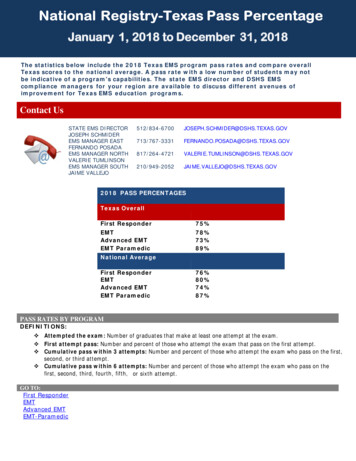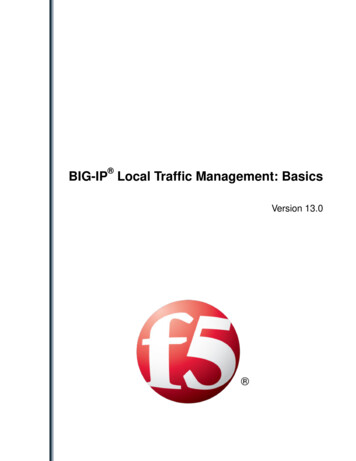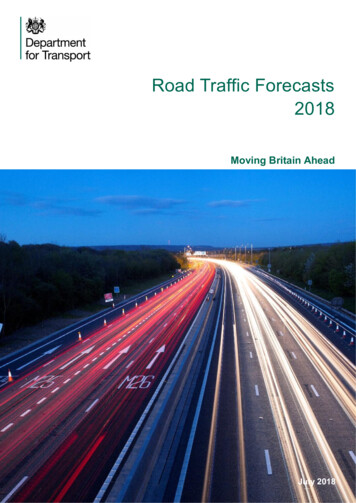
Transcription
Road Traffic Forecasts2018Moving Britain AheadJuly 2018
The Department for Transport has actively considered the needs of blind and partiallysighted people in accessing this document. The text will be made available in full on theDepartment’s website. The text may be freely downloaded and translated by individuals ororganisations for conversion into other accessible formats. If you have other needs in thisregard please contact the Department.Department for TransportGreat Minster House33 Horseferry RoadLondon SW1P 4DRTelephone 0300 330 3000Website www.gov.uk/dftGeneral enquiries: https://forms.dft.gov.uk Crown copyright 2018Copyright in the typographical arrangement rests with the Crown.You may re-use this information (not including logos or third-party material) free of chargein any format or medium, under the terms of the Open Government Licence. To view thislicence, visit ment-licence/version/3/or write to the Information Policy Team, The National Archives, Kew, London TW9 4DU, ore-mail: psi@nationalarchives.gsi.gov.ukWhere we have identified any third-party copyright information you will need to obtainpermission from the copyright holders concerned.
ContentsExecutive Summary5Introduction5Improvements to the Forecasts5What the Forecasts Show6Forecast Performance & Next Steps71. Introduction, Use of Forecasts & How the Model Works10Introduction10Use of the Forecasts11How the NTM Works12HGV & LGV Forecasting14Public Transport & Active Modes14NTM Recalibration & Update14Future Development of NTM15NTEM7.2 Update162. Evaluating Past Performance18Background18Summary of Results20Implications of Results253. Scenarios - Uncertainty and the Drivers of Demand27Introduction27Reference (Scenario 1) - Context, Assumptions & Inputs30High GDP, Low Fuel & Low GDP, High Fuel (Scenarios 2 & 3) – Context,Assumptions & Inputs31High Migration & Low Migration (Scenarios 4 & 5) – Context, Assumptions &Inputs35Extrapolated Trip Rates (Scenario 6) – Context, Assumptions & Inputs38Shift to Zero Emission Vehicles (ZEVs) (Scenario 7) – Context, Assumptions& Inputs42Trips (All Scenarios)43Car Ownership (All Scenarios)453
4. Summary of Results48Summary48What Drives the Growth?48Comparisons with RTF1550Results51Traffic51Vehicle Type53Road Type57Region60Congestion62Emissions685. Transport Technology74Introduction74Possible Impacts76Demand Sensitivity Tests80Supply Sensitivity Tests87Conclusions and Next Steps for Technology Tests896. Summary & Next Steps91Summary91Next Steps92Annex: Speed Flow Curves94Annex: Glossary of Terms and Acronyms984
Executive SummaryIntroduction1Road Traffic Forecasts 2018 (RTF18) present the latest forecasts for traffic demand,congestion and emissions in England and Wales up to the year 2050. These areproduced using the Department for Transport’s National Transport Model (NTM).2The forecasts provide the Department’s strategic view of future road travel demandunder a number of plausible scenarios that reflect the uncertainty in the key drivers ofroad traffic demand. The forecasts have been disaggregated by vehicle type, roadtype and region and are presented in this document, accompanying spreadsheetsand in the interactive Road Traffic Forecasts 2018 Visualisation Tool1.3This publication follows a substantial update to our modelling suite since Road TrafficForecasts 2015 (RTF15), with a recalibration of the NTM to a new base year of 2015and an updated National Trip End Model (NTEM) extending the forecast horizon to2050.4Understanding future demand for road travel is essential to shape the policies weimplement and the investments we make. However, forecasting future demand iscomplex and there is significant uncertainty about the extent to which existing trendsand relationships will carry on into the future. We need to ensure that we understandand communicate this uncertainty.5Within these forecasts, a scenarios approach has been taken to construct a numberof different plausible future outcomes. This provides a strategic view of keyuncertainties that might impact on future road traffic and supports the design ofstrategies and policies that are resilient to these uncertainties.6These forecasts are not definitive predictions about the future, or desired futures, butshow how demand for road travel may evolve assuming no change in governmentpolicy beyond that already announced. These forecasts have been produced using abroad range of research, evidence and data focusing on: Our understanding of how people make travel choices The possible paths of key drivers of travel demandImprovements to the Forecasts71The NTM has been updated to take into account the most recent traffic data andtrends in travel behaviour. The update rebases the model from 2003 to 2015,requiring a full recalibration, and takes all relevant up-to-date evidence and inputdata, whilst retaining the same functionality as the previous model.http://maps.dft.gov.uk/rtf18-vis5
8Since the publication of our last forecasts in RTF15, we have also comprehensivelyupdated the National Trip End Model (NTEM) to reflect more recent evidence. NTEMbrings together exogenous projections of population, employment and housingsupply and combines these with projections of car ownership and trip rates toforecast future numbers of trips by person type at a detailed spatial level.9In preparing RTF18 we have developed a new set of scenarios which aim to improveon RTF15 by considering a wider variety of uncertainty and combining multipleissues to create plausible future states of the world.10As part of this process we have reviewed the evidence on road demand and theuncertainty around a number of key drivers of road traffic, including: Population growth Trip rates GDP & Income Costs of driving Young people’s driving patterns and licence holding Demand for goods: freight Technology11After assessing the uncertainty around these key drivers of demand, we havecombined assumptions related to these issues where possible to create a set ofseven plausible, internally consistent scenarios. Further discussion of thesescenarios is set out in section 3.12Finally we have developed an interactive visualisation tool to allow users to easilynavigate through our model outputs and fully explore the forecast results. This can befound at http://maps.dft.gov.uk/rtf18-visWhat the Forecasts Show13Traffic in England and Wales is forecast to increase across all scenarios, but the sizeof that growth depends on the assumptions made about the key drivers of future roaddemand. From 2015 traffic is forecast to grow by between 17% and 51% by 2050.14The growth in traffic levels is predominately driven by the projected growth inpopulation levels (and thus the number of trips) and changes to vehicle runningcosts. Extrapolated Trip Rates (scenario 6), which explores the impacts ofextrapolating recent trip rate trends, has the lowest forecast growth of 17% by 2050.15Traffic growth on the Strategic Road Network (SRN) is forecast to be strong andpositive in all scenarios, ranging between growth of 29% and 59% by 2050, driven byforecast increases in the number of car trips and trip distances, as well as increasingLight Goods Vehicle (LGV) traffic. Forecast growth on principal roads and minorroads is lower than the SRN, between 10%-44% and 11%-48% respectively.16Car traffic is forecast to grow between 11% and 43% by 2050, whilst LGV traffic isforecast to continue growing significantly in all scenarios (between 23% and 108%).Strong LGV traffic growth has a significant impact on total traffic growth, particularlyin Extrapolated Trip Rates (scenario 6). In this scenario although car traffic is forecastto grow by just 11%, overall traffic growth still reaches 17% with LGV trafficaccounting for 19% of total traffic. HGV traffic growth is forecast to be lower than6
other vehicle types, with growth ranging from 5% to 12% by 2050.17Congestion is forecast to grow as a result of increases in traffic. The proportion oftraffic in congested conditions in 2050 is forecast to range from 8% to 16%depending on the scenario, compared to 7% in 2015. The average speed during allperiods is forecast to fall from 34mph in 2015 to as low as 31mph in 2050 in Shift toZEVs (scenario 7). The average delay per vehicle mile during all periods is forecastto increase by up to approximately 11 seconds per mile (69%) by 2050, althoughExtrapolated Trip Rates (scenario 6) specifically sees smaller increases (5%).18There is great uncertainty around the possible impact of transport technology on roadtraffic demand and it is unclear how far our existing understanding of the drivers ofdemand will continue to apply. In an attempt to address this, we have undertakensome initial exploratory analysis of how the introduction of Connected AutonomousVehicles (CAVs) may impact on demand through examining levers in existingmodels. The purpose of the analysis presented is not to make forecasts about howCAVs will impact on demand, but to better understand which aspects of these newtechnologies traffic levels might be most sensitive to, thus informing future researchpriorities. The range of traffic growth by 2050 in these tests is between 5% and 71%driven principally by uncertainty around possible changes to car occupancy levels,alongside possible changes to the perceived values of time and mobility.Forecast Performance & Next Steps1920We have reviewed the performance of RTF15 and the findings emphasise: that the forecasts performed well at the aggregate level the importance of keeping the base year and assumptions up-to-date the amount of uncertainty around road traffic demand (even in the short term). that the model is likely to overstate the level of traffic growth in London.Important elements to note given this: The base year of the NTM has been updated to 2015 for RTF18. In RTF18 we have reflected a broader range of factors in our scenarios, includingexploring the possible impacts of changes to population levels. The NTM is a national strategic transport model and therefore has difficultiesreplicating travel patterns at local levels where travel behaviour is substantiallydifferent from the national picture. This is particularly apparent in London wherethe relationship between income and car ownership differs. Whilst this is a knownfeature of the NTM and is not considered to have a material impact on theperformance of our forecasts at the national level, it should be considered iflooking at London outputs.21We recognise that our understanding of the drivers of road traffic demand continue toevolve and there is uncertainty around travel behaviour. We will continue to work ondeveloping the evidence base and forecasting approach to improve the transparencyand robustness of our strategic modelling capability.22Whilst we believe the technology-focused tests have explored some key features ofCAVs that may impact road traffic demand in the future, these developments presenta significant challenge to any forecasting activity. We shall explore ways in whichmodels may be used more effectively to forecast the impacts in more detail.7
8
9
1. Introduction, Use of Forecasts & Howthe Model WorksIntroduction1.1 Road Traffic Forecasts 2018 (RTF18) presents the latest forecasts of traffic demand,congestion and emissions in England and Wales produced using the Department forTransport’s National Transport Model (NTM).1.2 The forecasts provide the Department’s strategic view of future road travel demandunder a number of plausible scenarios that reflect the uncertainty in the key drivers ofroad traffic demand. The forecasts have been disaggregated by vehicle type, roadtype and region and are presented in this document and in the interactive RoadTraffic Forecasts 2018 Visualisation Tool. This can be found athttp://maps.dft.gov.uk/rtf18-vis.1.3 This publication comprises 6 core sections:1 How the forecasts are used and an overview of the approach to forecasting andthe modelling suite2 An evaluation of how the forecasts have performed in the past and how they havebeen updated since the last set of published forecasts3 Summary of the key drivers of road traffic demand and descriptions of ourscenarios based approach with specific detail on the narrative and coreassumptions of each scenario4 Presentation of results5 Description of the technology-focused tests and results6 Summary and next steps10
Use of the Forecasts1.4 The Road Traffic Forecasts are used to: inform the Department's roads strategy. The challenges which transport strategyand policy aim to overcome are strongly influenced by current and future trends intransport demand over the long term; understand how uncertainty around the key drivers of travel demand in the longterm could impact on future traffic growth; provide a sense-check of Highways England analysis in support of the 2nd RoadsInvestment Strategy (RIS2) and provide LGV and HGV forecasts. RIS2 analysis isprimarily to be developed by Highways England using, amongst other tools, theirRegional Traffic Models (RTMs).1.5 Given the strategic, high-level nature of the NTM, the forecasts are not used toappraise individual road schemes, nor are they intended to be used to consider theright level of capacity on a specific road or solutions to specific local issues.11
How the NTM Works1.6 Forecasting travel demand requires an understanding of the factors that influence it.The interactions between these factors and the nature of their relationship with traveldemand make traffic forecasting a complex process. The NTM takes a four-stagemultimodal approach to modelling travel behaviour which provides a robust way oftaking account of this complexity. However it is worth noting any model is bydefinition a simplified representation of a complex reality.1.7 Our modelling splits travel-making choices across four key decisions following theclassic 4-stage transport model approach:1 Whether to travel (Trip Generation) – whether a trip needs to be made (e.g. towork, the shops or to visit friends). The total number of trips are calculated bydetermining the frequency of productions and attractions in each zone by trippurpose. The choice of where to travel to is determined and constrained by thedistribution of destinations to travel to i.e. the location of jobs, schools and shops.The National Trip End Model (NTEM) dataset and suite of models provides aninitial forecast of travel demand based on: Households by size in the study area for each forecast year; Population by gender and age for each control area in each forecast year; and Employment (jobs) by industry, gender and working status in the control areafor each forecast year. Car Ownership (NATCOP, see Figure 1) by household type based on licenceholding, income, population, car costs and employment2 Where to travel to (Trip Distribution) - the demand model (PASS1 - seeFigure 1) matches productions with attractions determining where trips start andend and the distance of the trip.3 Which mode to travel by (Mode Choice) – taking into account the time andmonetary costs of travelling by different modes to distribute the trips from NTEMto different modes of transport in the demand model in NTM.4 Which route to be assigned to (Highway Assignment) – taking into accountthe time and monetary costs relating to using each route. This is handled inFORGE (see Figure 1) based on road capacity, forecast demand levels, costs ofdifferent modes as a result of congestion, speed flow curves (see Annex A) and acomprehensive database of actual traffic data.1.8 Analysing decisions using these four aspects helps explain the aggregate travelpatterns observed, identify where changes are occurring and where the mainuncertainties are. A diagrammatic representation of each of the above stages as wellas key inputs to the model can be seen in Figure 1.1.9 A more comprehensive description of how the NTM works can be found at the national-transport-mode12
Figure 1: Diagram of the National Transport Model & National Trip End Model13
HGV & LGV Forecasting1.10 Heavy Goods Vehicle (HGV) traffic and Light Goods Vehicle (LGV) traffic isgenerated by two separate sub-models within the NTM suite (see Figure 1). Thesetake into account the key drivers of demand that affect these vehicle types. Trafficgrowth from these models is fed into the NTM at the highway assignment stage(FORGE) to assess the impact of these vehicles on congestion.1.11 The GB Freight Model (GBFM) is a freight transport demand model forecasting HGVtraffic growth based on assumptions around future HGV fuel efficiencies and futuregrowth of manufacturing (captured in the manufacturing index).1.12 The manufacturing index is produced by the Department for Business, Energy andIndustrial Strategy (BEIS) in their Energy Demand Model which forecastsmanufacturing outputs by industry sub-sector based on GDP and terms of trade.1.13 LGV traffic growth is projected by the LGV Model, a regression based model thatforecasts LGV traffic using three main inputs:1 LGV lagged traffic (past two years’ traffic figures for LGVs)2 GDP per capita3 Average Fuel cost of an LGV (accounting for fuel prices, fuel efficiencies and fuelmakeup of the LGV fleet)Public Transport & Active Modes1.14 While this publication presents the Department's road traffic forecasts, the NTM takesaccount of the choice between walking, cycling, rail and bus as well as car. Thepurpose of the representation of other modes in the NTM is to ensure the relativeattractiveness of those modes are accounted for in the demand model in response tochanging costs, levels of congestion or policy changes. The Department hasspecialist models that are more detailed and appropriate for forecasting demand forthose specific modes.1.15 As relationships describing the impact of cycling and motor cycling on road capacityand traffic congestion are unavailable, these modes are not assigned to the NTMroad network and motor cycles are not modelled in the NTM.NTM Recalibration & Update1.16 This publication follows a substantial update to our modelling suite. The NTM hasbeen recalibrated to a new base year of 2015 and the National Trip End Model(NTEM) has been updated to version 7.2 allowing us to forecast out to 2050.1.17 A key objective for DfT was to update the NTM to ensure it continued to remain fit forthe purposes of strategic policy analysis and the quality assurance methods andframeworks that have been used for the project reflect that aspiration.1.18 The NTM has been updated to take into account the most recent traffic data andtrends in travel behaviour. The update rebases the model to 2015, requiring a full14
recalibration, and takes all relevant up-to-date evidence and input data, whilstretaining the same functionality and structure as the previous model. This is distinctfrom the project of developing a new National Transport Model.1.19 The update includes using latest travel and cost data to re-estimate the parameterswhich are used to allocate trips for different journey purposes across:(i) Modes; (options are, walk, cycle, bus, car driver or passenger and rail)(ii) Distance bands; (from less than 1 to over 200 miles) and(iii) Attraction zones. (Different urban & rural area types)1.20 Key highlights of the data updates are as follows: Updated behavioural parameters and costs based on the National Travel Survey(NTS) up to 2014 Up-to-date traffic data from Roads Traffic Statistics and Highways England toupdate the model’s traffic database, which is used to provide inputs to the modelon road length and kilometres travelled by road type, area type and sub region Updated forecasting assumptions, based on demand inputs from National TripEnd Model (NTEM) 7.2, which includes updated assumptions on trip rates andreflects the latest evidence from the NTS on the current trip-making
13 Trafficin England andWalesis forecast to increase acrossall scenarios, but the size of that growthdependson theassumptions madeabout the key drivers offuture road demand. From 2015 traffic isforecast to grow bybetween 17% and51% by2050. 14 The growth intraffic



